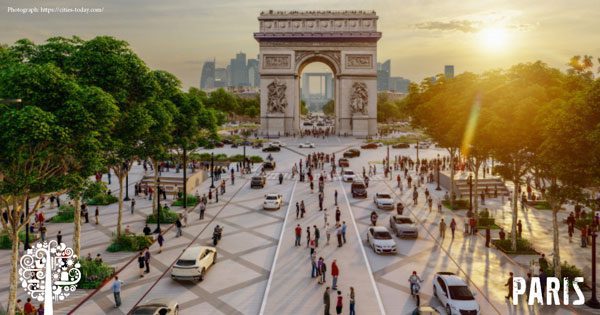While the rise of cities has brought plenty of benefits, the century of industrial growth and expansion of urban sprawl has also had adverse effects on the planet and city dwellers alike, such as the continued destruction and green space reduction. But as we head into the third decade of the 21st Century, some cities are looking to change that.
PARIS
There was a time when a stroll down the Champs-Elysees was on every traveler’s bucket list. Unfortunately, that has changed over the last few decades.
“The legendary avenue has lost its splendor over the past 30 years. It was gradually abandoned by the Parisians and suffered the full brunt of several respective crises: yellow vests, strikes, health and economic crisis, etc.”
-Statement from the Champs-Elysees Committee
Luckily, that luster is on its way back.

Paris mayor Anne Hidalgo has given the thumbs up to a fantastic (225 Million Euro) project that will see the famous avenue revitalized into a 1.9 kilometer stretch of greenery featuring tunnels of trees, green spaces, and pedestrian zones.
The city will half the number of cars traveling on the road, and the plans also include a large park around the Eiffel Tower.
One of the tenants of Hidalgo’s reelection campaign in 2020 was her goal to transform Paris into a 15-minute city: the idea that people could get to necessary amenities (schools, offices, shops, parks, health centers) within a 15-minute walk or bike ride.
MONTREAL
Now to a city known as “The Paris of North America,” Montreal, where the city’s mayor, Valerie Plante, has revealed the winning design for an incredible downtown greenspace makeover as well.
McGill College Avenue is in the heart of the city’s downtown core and, as the name suggests, heads out from the main entrance of the iconic McGill University.

While Montreal will only reveal the finalized plans in the spring, the basic idea is to turn the avenue into an urban forest of sorts.
The pedestrian-focused transformation will feature trees and bodies of water and is described by the design team as creating “a long bench-border along the wooded beaches… (incorporating) water and nature in an authentic and diverse urban environment.”
(Read about another amazing Montreal project here!)
BARCELONA
In 2016, Barcelona introduced its first superblock: a 9-block area with restricted car lanes, fewer vehicles (max speed 10km/h), and a focus on pedestrians.
Since then, they have introduced six more superblocks, but those are small potatoes compared to the new plan recently announced by mayor Ada Colau.
This new 10-year plan aims to create a super-superblock encompassing 21 streets in the Eixample district.
The only cars allowed on the district streets will belong to residents, essential services, or deliveries. They will also plant lots of trees that will shade 6.6 hectares of new green space in an area containing 33.4 hectares of added pedestrian space.
A public competition will determine the exact design of it all, and work is set to get started in 2022 at the cost of 38 Million Euros.